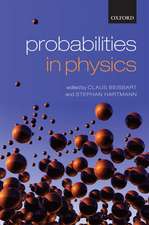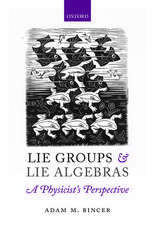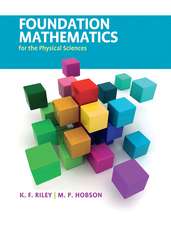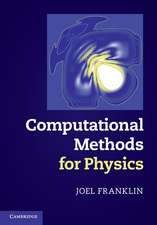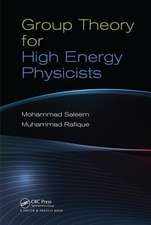The Mathematical Structure of Classical and Relativistic Physics: A General Classification Diagram: Modeling and Simulation in Science, Engineering and Technology
Autor Enzo Tontien Limba Engleză Hardback – 7 sep 2013
The book is divided into three parts. The first introduces the framework for the above-mentioned classification, methodically developing a geometric and topological formulation applicable to all physical laws and properties; the second applies this formulation to a detailed study of particle dynamics, electromagnetism, deformable solids, fluid dynamics, heat conduction, and gravitation. The third part further analyses the general structure of the classification diagram for variables and equations of physical theories.
Suitable for a diverse audience of physicists, engineers, and mathematicians, The Mathematical Structure of Classical and Relativistic Physics offers a valuable resource for studying the physical world. Written at a level accessible to graduate and advanced undergraduate students in mathematical physics, the book can be used as a research monograph across various areas of physics, engineering and mathematics, and as a supplemental text for a broad range of upper-levelscientific coursework.
| Toate formatele și edițiile | Preț | Express |
|---|---|---|
| Paperback (1) | 496.80 lei 38-45 zile | |
| Springer – 23 aug 2016 | 496.80 lei 38-45 zile | |
| Hardback (1) | 657.15 lei 38-45 zile | |
| Springer – 7 sep 2013 | 657.15 lei 38-45 zile |
Din seria Modeling and Simulation in Science, Engineering and Technology
-
 Preț: 410.88 lei
Preț: 410.88 lei - 18%
 Preț: 958.38 lei
Preț: 958.38 lei - 18%
 Preț: 784.13 lei
Preț: 784.13 lei - 15%
 Preț: 551.02 lei
Preț: 551.02 lei - 15%
 Preț: 642.68 lei
Preț: 642.68 lei -
 Preț: 392.60 lei
Preț: 392.60 lei -
 Preț: 388.34 lei
Preț: 388.34 lei - 18%
 Preț: 950.03 lei
Preț: 950.03 lei - 15%
 Preț: 643.84 lei
Preț: 643.84 lei - 15%
 Preț: 649.39 lei
Preț: 649.39 lei - 15%
 Preț: 644.18 lei
Preț: 644.18 lei - 20%
 Preț: 651.57 lei
Preț: 651.57 lei - 18%
 Preț: 1238.42 lei
Preț: 1238.42 lei - 15%
 Preț: 639.25 lei
Preț: 639.25 lei -
 Preț: 399.12 lei
Preț: 399.12 lei - 15%
 Preț: 650.19 lei
Preț: 650.19 lei -
 Preț: 387.58 lei
Preț: 387.58 lei -
 Preț: 392.97 lei
Preț: 392.97 lei -
 Preț: 396.24 lei
Preț: 396.24 lei - 15%
 Preț: 661.32 lei
Preț: 661.32 lei -
 Preț: 396.24 lei
Preț: 396.24 lei - 18%
 Preț: 943.88 lei
Preț: 943.88 lei - 18%
 Preț: 1386.17 lei
Preț: 1386.17 lei - 15%
 Preț: 648.42 lei
Preț: 648.42 lei - 15%
 Preț: 648.24 lei
Preț: 648.24 lei -
 Preț: 405.06 lei
Preț: 405.06 lei - 15%
 Preț: 641.38 lei
Preț: 641.38 lei - 15%
 Preț: 649.71 lei
Preț: 649.71 lei - 18%
 Preț: 1220.88 lei
Preț: 1220.88 lei - 15%
 Preț: 640.06 lei
Preț: 640.06 lei - 18%
 Preț: 952.26 lei
Preț: 952.26 lei - 15%
 Preț: 640.88 lei
Preț: 640.88 lei -
 Preț: 383.50 lei
Preț: 383.50 lei - 18%
 Preț: 1232.26 lei
Preț: 1232.26 lei - 15%
 Preț: 644.49 lei
Preț: 644.49 lei - 15%
 Preț: 655.60 lei
Preț: 655.60 lei -
 Preț: 400.26 lei
Preț: 400.26 lei
Preț: 657.15 lei
Preț vechi: 853.45 lei
-23% Nou
Puncte Express: 986
Preț estimativ în valută:
125.75€ • 134.47$ • 104.84£
125.75€ • 134.47$ • 104.84£
Carte tipărită la comandă
Livrare economică 14-21 aprilie
Preluare comenzi: 021 569.72.76
Specificații
ISBN-13: 9781461474210
ISBN-10: 1461474213
Pagini: 552
Ilustrații: XXXVI, 514 p. 164 illus. in color.
Dimensiuni: 155 x 235 x 35 mm
Greutate: 0.94 kg
Ediția:2013
Editura: Springer
Colecția Birkhäuser
Seria Modeling and Simulation in Science, Engineering and Technology
Locul publicării:New York, NY, United States
ISBN-10: 1461474213
Pagini: 552
Ilustrații: XXXVI, 514 p. 164 illus. in color.
Dimensiuni: 155 x 235 x 35 mm
Greutate: 0.94 kg
Ediția:2013
Editura: Springer
Colecția Birkhäuser
Seria Modeling and Simulation in Science, Engineering and Technology
Locul publicării:New York, NY, United States
Public țintă
GraduateCuprins
1 Introduction.- Part I Analysis of variables and equations.- 2 Terminology revisited.- 3 Space and time elements and their orientation.- 4 Cell complexes.- 5 Analysis of physical variables.- 6 Analysis of physical equations.- 7 Algebraic topology.- 8 The birth of the classification diagrams.- Part II Analysis of physical theories.- 9 Particle dynamics.- 10 Electromagnetism.- 11 Mechanics of deformable solids.- 12 Mechanics of fluids.- 13 Other physical theories.- Part III Advanced analysis.- 14 General structure of the diagrams.- 15 The mathematical structure.- Part IV Appendices.- A Affine vector fields.- B Tensorial notation.- C On observable quantities.- D History of the diagram.- D.1 Historical remarks.- E List of physical variables.- F List of symbols used in this book.- G List of diagrams.- References.
Recenzii
From the book reviews:
“The author studies the mathematical structure of classical and relativistic physics with a non-standard approach. … the books can be highly recommended for readers from mathematics, physics and engineering, in particular for readers looking for an alternative approach to classical and relativistic physics.” (Willi-Hans Steeb, zbMATH, Vol. 1298, 2014)
“The author studies the mathematical structure of classical and relativistic physics with a non-standard approach. … the books can be highly recommended for readers from mathematics, physics and engineering, in particular for readers looking for an alternative approach to classical and relativistic physics.” (Willi-Hans Steeb, zbMATH, Vol. 1298, 2014)
Textul de pe ultima copertă
The theories describing seemingly unrelated areas of physics have surprising analogies that have aroused the curiosity of scientists and motivated efforts to identify reasons for their existence. Comparative study of physical theories has revealed the presence of a common topological and geometric structure. The Mathematical Structure of Classical and Relativistic Physics is the first book to analyze this structure in depth, thereby exposing the relationship between (a) global physical variables and (b) space and time elements such as points, lines, surfaces, instants, and intervals. Combining this relationship with the inner and outer orientation of space and time allows one to construct a classification diagram for variables, equations, and other theoretical characteristics.
The book is divided into three parts. The first introduces the framework for the above-mentioned classification, methodically developing a geometric and topological formulation applicable to all physical laws and properties; the second applies this formulation to a detailed study of particle dynamics, electromagnetism, deformable solids, fluid dynamics, heat conduction, and gravitation. The third part further analyses the general structure of the classification diagram for variables and equations of physical theories.
Suitable for a diverse audience of physicists, engineers, and mathematicians, The Mathematical Structure of Classical and Relativistic Physics offers a valuable resource for studying the physical world. Written at a level accessible to graduate and advanced undergraduate students in mathematical physics, the book can be used as a research monograph across various areas of physics, engineering and mathematics, and as a supplemental text for a broad range of upper-levelscientific coursework.
The book is divided into three parts. The first introduces the framework for the above-mentioned classification, methodically developing a geometric and topological formulation applicable to all physical laws and properties; the second applies this formulation to a detailed study of particle dynamics, electromagnetism, deformable solids, fluid dynamics, heat conduction, and gravitation. The third part further analyses the general structure of the classification diagram for variables and equations of physical theories.
Suitable for a diverse audience of physicists, engineers, and mathematicians, The Mathematical Structure of Classical and Relativistic Physics offers a valuable resource for studying the physical world. Written at a level accessible to graduate and advanced undergraduate students in mathematical physics, the book can be used as a research monograph across various areas of physics, engineering and mathematics, and as a supplemental text for a broad range of upper-levelscientific coursework.
Caracteristici
Presents an original mathematical analysis of the underlying analogies in diverse branches of physics Provides a novel classification of physical variables A valuable resource across many disciplines in applied mathematics, physics, and engineering Clear exposition includes hundreds of figures to enhance understanding Useful for both advanced students and professional researchers Includes supplementary material: sn.pub/extras



